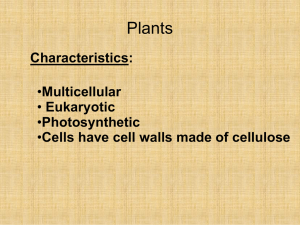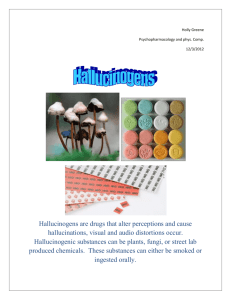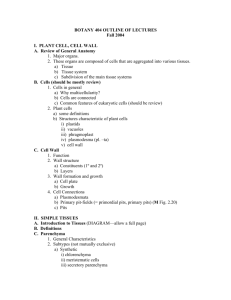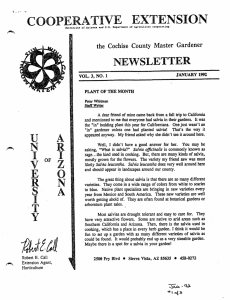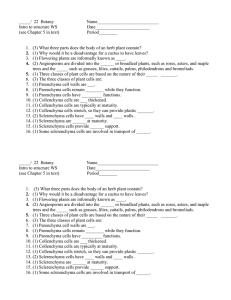THE MORPHOLOGICAL AND ANATOMICAL CHARACTERS OF P B C
advertisement
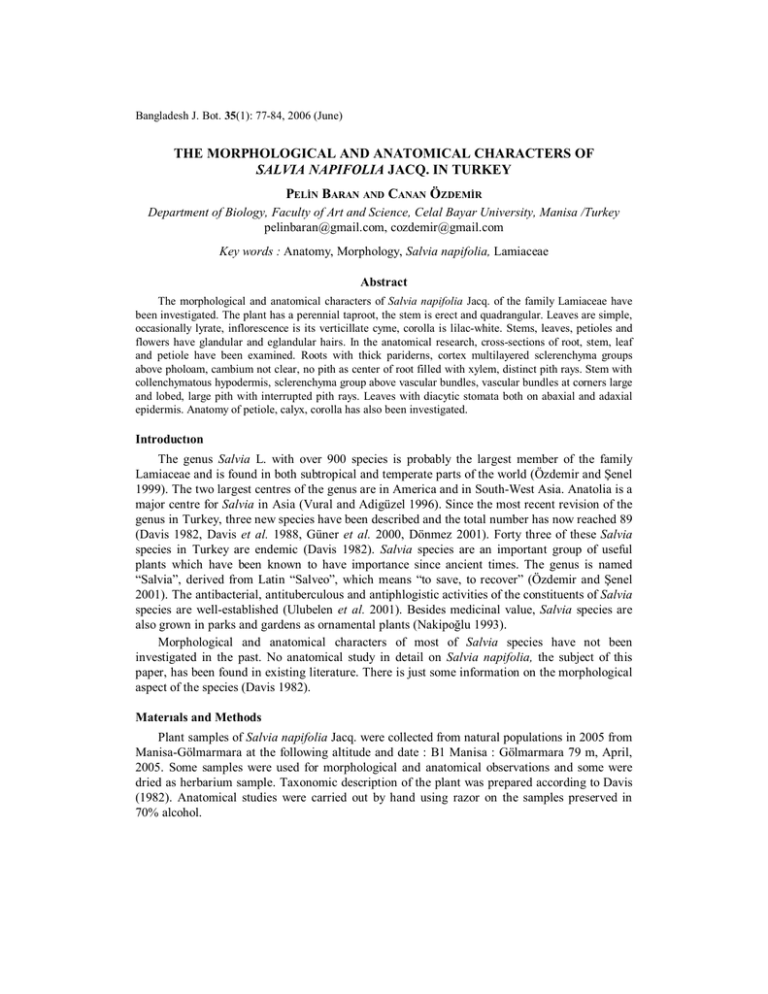
Bangladesh J. Bot. 35(1): 77-84, 2006 (June) THE MORPHOLOGICAL AND ANATOMICAL CHARACTERS OF SALVIA NAPIFOLIA JACQ. IN TURKEY PEL N BARAN AND CANAN ÖZDEM R Department of Biology, Faculty of Art and Science, Celal Bayar University, Manisa /Turkey pelinbaran@gmail.com, cozdemir@gmail.com Key words : Anatomy, Morphology, Salvia napifolia, Lamiaceae Abstract The morphological and anatomical characters of Salvia napifolia Jacq. of the family Lamiaceae have been investigated. The plant has a perennial taproot, the stem is erect and quadrangular. Leaves are simple, occasionally lyrate, inflorescence is its verticillate cyme, corolla is lilac-white. Stems, leaves, petioles and flowers have glandular and eglandular hairs. In the anatomical research, cross-sections of root, stem, leaf and petiole have been examined. Roots with thick pariderns, cortex multilayered sclerenchyma groups above pholoam, cambium not clear, no pith as center of root filled with xylem, distinct pith rays. Stem with collenchymatous hypodermis, sclerenchyma group above vascular bundles, vascular bundles at corners large and lobed, large pith with interrupted pith rays. Leaves with diacytic stomata both on abaxial and adaxial epidermis. Anatomy of petiole, calyx, corolla has also been investigated. Introduct on The genus Salvia L. with over 900 species is probably the largest member of the family Lamiaceae and is found in both subtropical and temperate parts of the world (Özdemir and enel 1999). The two largest centres of the genus are in America and in South-West Asia. Anatolia is a major centre for Salvia in Asia (Vural and Adigüzel 1996). Since the most recent revision of the genus in Turkey, three new species have been described and the total number has now reached 89 (Davis 1982, Davis et al. 1988, Güner et al. 2000, Dönmez 2001). Forty three of these Salvia species in Turkey are endemic (Davis 1982). Salvia species are an important group of useful plants which have been known to have importance since ancient times. The genus is named “Salvia”, derived from Latin “Salveo”, which means “to save, to recover” (Özdemir and enel 2001). The antibacterial, antituberculous and antiphlogistic activities of the constituents of Salvia species are well-established (Ulubelen et al. 2001). Besides medicinal value, Salvia species are also grown in parks and gardens as ornamental plants (Nakipo lu 1993). Morphological and anatomical characters of most of Salvia species have not been investigated in the past. No anatomical study in detail on Salvia napifolia, the subject of this paper, has been found in existing literature. There is just some information on the morphological aspect of the species (Davis 1982). Mater als and Methods Plant samples of Salvia napifolia Jacq. were collected from natural populations in 2005 from Manisa-Gölmarmara at the following altitude and date : B1 Manisa : Gölmarmara 79 m, April, 2005. Some samples were used for morphological and anatomical observations and some were dried as herbarium sample. Taxonomic description of the plant was prepared according to Davis (1982). Anatomical studies were carried out by hand using razor on the samples preserved in 70% alcohol. 78 BARAN AND ÖZDEM R Results and Discussion Morphological characters: The tap roots of S. napifolia is thick with dark brown outer covering. Stem crect, quadrangular, pilose bellow and villous above. Leaves petiolate, petiole pilose; simple, ovate-broadly ovate, occasionally lyrate, crenate to cerose, unicostate-reticulate, faintly hairy. Inflorescence verticillate-cyme, 5-6 flowers in a verticel. Flowrs bracteate, bracts broadly ovate, acuminate, or sometime ± circular, Zygomorphic, bright red in colour. Fig. 1. General appearence and some parts of Salvia napifolia. A-B. General appearence, C. calyx, D. corolla, E. pistil, F. stamens, G. seed, H. bract and I. leaf. Calyx bilabiate, campanulate, upper lip tridentate, lower lip bidentate, villous. Corolla bilabiate, upper lip of two lobes slightly falcate and lilae and lower of three lobes white in colour. The median lobe of lower lip biggest and concave. The lower part of corolla tube ventricose. Fertile stamens two; stigma unequally bifurecated. Nutlets-4, trigonous, dark brown. Stem, leaf, petiole, pedicel, calyx and corolla covered with glandular and eglandular hairs. (Fig. 1, Table 1). 79 THE MORPHOLOGICAL AND ANATOMICAL CHARACTERS Table 1. Morphological measurements of plant organs of Salvia napifolia. Platn part Parameter Min. - Max. (cm) Mean ± S.D. (cm) Root Stem Leaf Root length Stem length Leaf length Leaf width Petiole length Pedicel length Calyx length Length of calyx teeth Corolla length Filament length Anther length Pistil length Bract length Bract width Seed length Seed width 11 - 30 18 - 35 1.6 - 6.6 0.7 - 3.5 0.4 - 9.8 0.1 - 0.4 0.45 - 1.0 0.05 - 0.60 0.70 - 1.25 0.15 - 0.30 0.15 - 0.25 0.8 - 1.20 0.25 - 1.30 0.45 - 1.20 0.22 - 0.25 0.16 - 0.20 18.4 ± 7.3 26.9 ± 7.3 3.88 ± 1.63 2.03 ± 0.85 5.31 ± 2.69 0.3 ± 0.10 0.68 ± 0.18 0.24 ± 0.20 1.03 ± 0.13 0.22 ± 0.06 0.21 ± 0.02 0.70 ± 0.24 0.65 ± 0.35 0.70 ± 0.24 0.24 ± 0.01 0.18 ± 0.01 Petiole Flower Bract Seed S.D. = Standard deviation. Anatomical charracters Root : There was a thick peridermis. Cortex was multilayered and parenchymatic under the peridermis. Many sclerenchyma groups, 2 - 6 or more celled, were present among flattened cortex parenchyma cells. Sclerenchyma groups were also present above phloem. Clear and large phloem was interrupted by pith rays as to form groups. Cambium was not clear. Center of root was entirely filled with xylem. There were 2 - 6 rowed, thin or thick pith rays (Fig. 2 A, Table 2). Stem: The cross-section of stem was quadrangular. Epidermis was single layered. Collenchyma was 12 - 16 layered under epidermis, projecting at the corners of stem, becoming thin towards edges. Cortex parenchyma under epidermis was 5 - 10 layered and under collenchyma 3 - 5 layered. Thick sclerenchyma groups were present above vascular bundles at the corners. Phloem was located under sclerenchyma. Cambium was not very clear. Thickness of xylem part was as much as sclerenchyma plus phloem. Vascular bundles at the corners were large and sometimes lobed (Fig. 2 B). Vascular bundles at the edges were very small and 4 - 5 in number (Fig. 2 C). Pith rays interrupted, 1 - 3 rowed. A large pith under vascular bundles was present at the center of stem. Trachea cells were arranged at the same line (Fig. 2 B-C, Table 2). Leaf : There was a single layered epidermis on both adaxial and abaxial surface of leaf. Epidermal cells were oval, squarish or nearly rectangular in the cross-section. Palisade parenchyma was 2 - 4 layered and spongy parenchyma 3 - 4 layered. Palisade and spongy parenchyma cells had a lot of chloroplast. Stomata were present on both adaxial and abaxial epidermis. Stoma type was diacytic. The median vein of leaf was surrounded by lacunar collenchyma, 2 - 3 layered collenchyma was present under the adaxial epidermis while 2 layers of 80 BARAN AND ÖZDEM R parenchyma cells adjacent to the abaxial epidermis were thick walled in respect the inner parenchyma cells in leaf (Fig. 3 G, Table 2). Petiole : The outermost layer of petiole in cross-section consisted of oval, squarish or nearly rectangular epidermal cells. Collenchyma was 2 - 5 layered under abaxial epidermis, gradually becoming thin towards both ends. Parenchyma was 11 - 15 layered. Parenchyma cells were nearly Fig. 2. The root (A) and stem (B, C) sections of Salvia napifolia, e = exepidermis, pe = peridermis, ph = phloem, t = trachea, p = pith, cp = cortex parenchyma, pr = pith ray, s = sclerenchyma, t = xylem. 81 THE MORPHOLOGICAL AND ANATOMICAL CHARACTERS circular. Type of vascular bundle was collateral. At the cross-sections taken from median level of petiole, it has been observed that the number of vascular bundle in the center differed. There were 1, 2 or 3 vascular bundles in the center and 1 - 3 small vascular bundles at the ends. The central vascular bundles were sometimes single and lobed or divided into 2 - 3 pieces. The 2 pieced central vascular bundles had lobe while 3 pieced ones had no lobe. Sclerenchyma upon the central vascular bundles was thick. Phloem was located between sclerenchyma and xylem. The central vascular bundles had 32 - 33 xylem rays (Fig. 3 A - F, Table 2). Table 2. Anatomical measurements of various tissues of Salvia napifolia. Parameters Root Peridermis cell Parenchyma cell Pith ray Trachea cell Stem Cuticle Epidermis cell Parenchyma Trachea cell Pith cell Leaf Cuticle Adaxial epidermis cell Abaxial epidermis cell Mesophyll region Palisade region Spongy region Palisade cell Spongy cell Petiole Adaxial epidermis cell Abaxial epidermis cell Parenchyma cell Trachea cell Calyx Adaxial epidermis cell, Width (µm) Min. - Max. Mean ± S.D. 10.7 - 32.1 21.4 - 79.4 6.8 - 524.8 15.9 - 100.6 21.42 ± 8.46 51.0 ± 21.3 95.3 ± 126 51.5 ± 31.4 5.3 - 13.2 7.9 - 37.1 26.8 - 85.7 5.3 - 52.9 10.7 - 32.1 9.3 ± 3.4 21.2 ± 12.6 50.4 ± 24.4 26.8 ± 19.9 21.4 ± 8.5 3.4 - 20.4 8.2 - 81.8 10.9 - 46.4 129.9 - 523.6 61.2 - 278.8 54.4 - 264 10.9 - 29.9 13.6 - 32.7 12.3 ± 5.4 36.2 ± 24.7 25.7 ± 13.1 335.6 ± 126.8 176.2 ± 68.7 129.8 ± 73.8 21.1 ± 6.1 23.2 ± 6.6 10.9 - 40.9 5.5 - 27.3 26.8 - 150.0 10.6 - 37.1 Length (µm) Min. - Max. Mean ± S.D. 5.4 - 21.4 16.1 - 42.9 13.4 ± 6.9 32.0 ± 11.0 5.3 - 15.9 10.6 ± 4.2 16.4 - 95.5 10.9 - 54.5 39.7 ± 21.6 26.3 ± 13.6 24.5 - 95.5 53.4 ± 22.9 22.5 ± 9.2 15.0 ± 7.9 84.6 ± 49.0 24.4 ± 9.7 16.4 - 35.5 13.6 - 32.7 26.0 ± 6.4 23.0 ± 7.5 9.6 - 54.5 31.1 ± 21.0 13.6 - 51.8 28.6 ± 17.4 19.1 - 54.5 39.8 ± 13.2 27.3 - 54.5 36.5 ± 10.8 10.9 - 32.7 20.6 ± 9.0 8.2 - 19.1 13.2 ± 3.3 sinuous walled Abaxial epidermis cell, sinuous walled Parenchyma cell Corolla 82 Adaxial epidermis cell Abaxial epidermis cell Parenchyma cell BARAN AND ÖZDEM R 12.3 - 38.2 16.4 - 29.9 10.9 - 35.5 22.7 ± 8.1 24.7 ± 5.1 21.8 ± 11.3 13.6 - 32.7 16.4 - 35.5 8.2 - 27.3 22.0 ± 6.0 30.6 ± 7.4 15.0 ± 7.8 S.D. = Standard deviation. Calyx : Adaxial and abaxial epidermis were single layered. Abaxial epidermal cells were usually larger than the adaxial ones. Parenchyma was 3 - 5 layered. Parenchyma cells were flattened or nearly rectangular and filled with a lot of chloroplasts. Epidermis had stoma. Epidermal cells were sinuous walled in the superficial sections (Table 2). Fig. 3. The (A - F) petiole and leaf (G) sections of Salvia napifolia, pa = parenchyma, s = sclerenchyma, ph = phloem, x = xylem, cu = cuticle, ad = adaxial epidermis, pp = palisade parenchyma, v = vascular bundle, sp = spongy parenchyma, ab = abaxial epidermis. THE MORPHOLOGICAL AND ANATOMICAL CHARACTERS 83 Corolla : A thin cuticle surrounded epidermal cells. The outer surfaces of abaxial epidermal cells were sometimes with papilla. Abaxial epidermal cells are usually larger than adaxial epidermal cells. Parenchyma was 3 - 4 layered and had intercellular spaces (Table 2). The genus Salvia comprises of about 89 species, some of which are of economic value. The authors aimed to introduce S. napifolia morphologically and anatomically in detail in this paper. It is stated that there is mucilage on the seed coat of Lamiaceae family, including Salvia seeds, which may help to germinate easily, keeping the seeds wet (Fahn 1977, Davis 1982). This clear mucilage that the seeds give off on wetting is used for lacquerware and is mixed with fruit juices to produce pleasant drinks in Mexico (Estilai et al. 1990). In the Eastern Turkey the mucilage is used for the treatment of eye diseases (Baytop 1999). The leaf venation of S. napifolia was pinnate reticulate. The present findings of S. napifolia were compared with the anatomical studies made on the genus Salvia in literature. Few researchers observed schlerenchyma groups in the root cortex of some Salvia species (Çobano lu 1988, Çobano lu et al. 1992). The root of S. forskahlei L. has a sclerenchymatic ring in addition to sclerenchyma groups at the cortex (Özdemir and enel 2001). The root cortex of S. napifolia had clear sclerenchyma groups of 2 - 6 or more celled both upon phloem and in cortex parenchyma. No sclerenchymatic ring was seen. Pith rays of Lamiaceae family are 2 - 12 or more rowed and quite heterogeneous in structure (Metcalfe and Chalk 1972). In Salvia species examined in the literature, pith rays are 1 - 10 rowed and root center is filled with primary xylem (Çobano lu 1988, Çobano lu et al. 1992, Özdemir and enel 1999). The root center of S. forskahlei has a large pith consisting of parenchymatic cells and the pith rays are 2 - 40 rowed (Özdemir and enel 2001). The root center of S. napifolia was filled with xylem and the pith rays were 2 - 6 rowed. Number of rows in pith rays can be used as a species-distinguishing feature, because it differs in every species. The characteristic feature of Lamiaceae family is a quadrangular stem and a well-developed collenchyma, supporting tissue at the corners of stem (Metcalfe and Chalk 1972). The stem of S. napifolia was quadrangular and had a well-developed collenchyma at the corners. Woody stem of S. forskahlei has sclerenchyma groups upon the phloem and also a sclerenchymatic ring upon the sclerenchyma groups, but the herbaceous stem has only a sclerenchymatic ring (Özdemir and enel 2001). The stem of S. napifolia had large sclerenchyma groups upon the phloem and did not have any sclerenchymatic ring. Cambium in some Salvia species examined is 2 - 3 layered or sometimes unclear (Çobano lu 1988, Özdemir and enel 1999, 2001). The cambium of S. napifolia was not clear. Leaf mesophyll of Salvia species is entirely parenchymatic and the median vein of leaf is surrounded by collenchyma (Metcalfe and Chalk 1972). Lacunar collenchyma forming around intercellular spaces is present in Salvia genus (Yentür 1995). The authors found the same characteristics in S. napifolia. The arrangement of vascular bundles in the petiole of Lamiaceae species is important from the taxonomic point of view (Metcalfe and Chalk 1972). Nakipo lu and O uz (1990) separated the vascular bundles of 7 Salvia species into two groups such as those species with basal leaves and those without basal leaves. According to this separation, the central vascular bundle of the species with basal leaves is divided into 3 pieces, while that of the species without basal leaves is single, large and undivided. In S. napifolia, a plant with basal leaves, the authors observed 1, 2 or 3 central vascular bundles and 1 - 3 small bundles at each end of petiole. These findings suggest that although S. napifolia is a plant with basal leaves, the number of central vascular bundle of petiole shows variation, being sometimes divided into 2-3 pieces or sometimes single, large and lobed in contrast to that of Nakipo lu and O uz (1990). Epidermis cells of the calyx and corolla of S. sclarea L. have 84 BARAN AND ÖZDEM R sometimes papilla on their outer surfaces (Özdemir and enel 1999). In S. napifolia, sometimes epidermal cells of the corolla had papilla. In conclusion, it can be inferred that there were some differences besides the similarities between S. napifolia and the other Salvia species in literature. S. napifolia was covered with glandular hairs which produce essential oil having a pleasant smell. We suggest that S. napifolia may be important in medicine and economy because of its fragrant essential oil. In addition, S. napifolia with lilac flowers and the leaves forming a rosette at the base can be also used as an ornamental plant in parks and gardens. References Baytop T. 1999. Türkiye’de Bitkilerle Tedavi (Geçmi te ve Bugün). 2. Bask , Nobel T p Kitapevleri, Çapastanbul, Konak- zmir, S hh ye-Ankara, pp. 142-144. Çobano lu D. 1988. Salvia palaesthina Bentham’ n (Lamiaceae) Morfolojik ve Sitolojik Özellikleri. Do a Bilim Dergisi: Biyoloji 12: 215-223. Çobano lu D., S. Özel and H. Evren. 1992. Salvia trichoclada Benth. (Lamiaceae). In: Morfolojik Özelikleri. XI. Ulusal Biyoloji Kongresi, Elaz , 24-27 Haziran, Botanik, 83-89. Davis PH. 1982. Flora of Turkey and The East Aegean Islands. Vol. 7, Edinburg Univ. Press, Edinburg, pp. 400-402. Davis P.H., R.R. Mill and K. Tan. 1988. Flora of Turkey and The East Aegean Islands. Vol.10, Edinburg Univ. Press, Edinburg, pp. 201-210. Dönmez A.A. 2001. A new Turkish species of Salvia L. (Lamiaceae). Bot. J. Linn. Soc. 137(4): 413-416. Estilai A., A. Hashemi and K. Truman. 1990. Chromosome Number and Meiotic Behavior of Cultivated Chia, Salvia hispanica (Lamiaceae). Hortscience 25(12): 1646-1647. Fahn A. 1977. Plant Anatomy. 2nd edn., Permagon Press, Oxford. Güner, A., N. Özhatay, T. Ekim and K.H.C. Ba er. 2000. Flora of Turkey and The East Aegean Islands. Vol.11, Edinburg Univ. Press, Edinburg, pp. 197-209. Metcalfe J.R. and L. Chalk. 1972. Anatomy of the Dicotyledons. Vol. 2, Clarendon Press, Oxford, pp. 10411053. Nakipo lu M. and G. O uz. 1990. zmir Çevresinde Yay gösteren Baz Salvia (Adaçay ) Türlerinin Biyosistemati i Üzerine Ara rmalar. E. Ü. Fen Bil. Enst. Derg. 1(2): 23 29. Nakipo lu, M. 1993. Baz Adaçay (Salvia L.) Türleri ve Bu Türlerin Ekonomik Önemi. Dokuz Eylül Üniversitesi Yay nlar , E itim Fakültesi, itim Bilimleri Dergisi, Say : 6, Y l: 2, Shf: 45-58. Özdemir C. and G. enel. 1999. The Morphological, Anatomical and Karyological Properties of Salvia sclarea L. Turk. J. Bot. 23: 7-18. Özdemir C. and G. enel. 2001. The Morphological, Anatomical and Karyological Properties of Salvia forskahlei L. (Lamiaceae) in Turkey. J. Econ. Taxon. Bot. 19: 297-313. Ulubelen A., S. Öksüz, G. Topçu, A.C. Gören and W. Voelter. 2001. Antibacterial diterpenes from the roots of Salvia blepharochlaena. J. Nat. Prod. 64(4): 549-551. Vural A. and N. Adigüzel. 1996. A New Species from Central Anatolia: Salvia aytachii M. Vural et N. Ad güzel (Labiatae). Turk. J. Bot. 20(6): 531-534. Yentür, S. 1995. Bitki Anatomisi. stanbul Üniv. Fen Fak. Yay., stanbul. (Manuscript received on 25 April, 2006; revised on 7 May, 2006) THE MORPHOLOGICAL AND ANATOMICAL CHARACTERS 85


